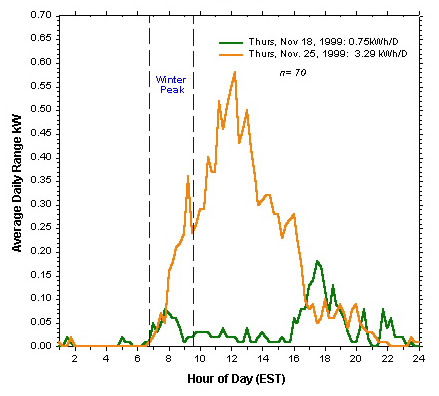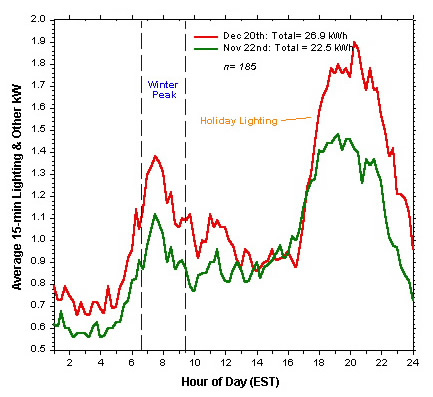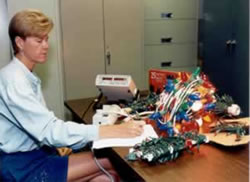
![]()
Over the years, FSEC has had occasion to measure many things. Among them are the amount of energy it takes to cook a holiday turkey dinner and the energy use of holiday lighting.

The plot below shows the comparison between stove and range energy use on the Thursday before Thanksgiving with that on Thanksgiving day, one week later, in 1999. The data come from 70 randomly selected "typical" central Florida homes and clearly show the impact of cooking a holiday dinner in the middle of the day. Stove and range use on Thanksgiving day averaged 3.29 - 0.75 = 2.54 kWh per day more than on the preceding Thursday.

Energy-Efficient Holiday Lighting
In a bid to outdo his neighbors in National Lampoon's "Christmas Vacation," Clark W. Griswold, installs 25,000 Christmas lights on his home at great risk of personal injury. As those seeing the movie may recall, when Griswold's wife finally manages to find out why the entire string refuses to illuminate (not plugged in!), the lights create a blinding nighttime display. The electric service meter spins and smokes, the neighborhood street lights dim and someone off-site throws a lever for more generation at the local utility!
Perhaps not too far from reality. FSEC's measurements of holiday lighting energy use show an average increase in lighting use of 4.4 kWh per day for holiday lighting (on average, about $13 per 30-day holiday season). Comparing the lighting energy use in 185 homes before and during the 1999 holiday season, the plot below shows an average load increase of about 400 watts in the early evening hours, continuing through the night at about 200 watts until mid day the following day. This indicates that many households leave their holiday lighting on all night and far into the following day.

Obviously, this is only an average, however. Non-participating Ebenezer types consume nothing more, while those determined to put on a gonzo display — like Clark Griswold — will use a lot more. But just how much more?

In the mid-1990's FSEC undertook a small effort to determine how much power holiday lighting consumes. Using a sensitive Valhalla 2100 power analyzer, the power use of different types of holiday lighting was determined. The photo at the right shows FSEC engineer Lynn Schrum performing this evaluation.
As seen in the following table, results show a very large difference (30 to 1) in the per bulb energy use for different types of holiday lighting systems.
Results of Holiday Lighting Power Use Measurements
| Holiday Lighting Type | Measured Watts |
No. of Bulbs |
Watts per Bulb |
| Clear mini bulbs (W2 type, indoor/outdoor) | 34.1 |
100 |
0.34 |
| Colored mini bulbs (W2 type, indoor only) | 33.4 |
100 |
0.33 |
| Colored C-7 5W bulbs (indoor/outdoor) | 128.0 |
25 |
5.12 |
| Colored C large 10W bulbs (outdoor) | 504.4 |
50 |
10.17 |
More recently, new high-tech LED (Light Emitting Diode) holiday lighting systems have come into the marketplace with an advertised per bulb energy use down to 0.04 watts, decreasing the per bulb energy use given in the above table by yet another factor of 10! Additional information on these new LED lighting systems can be found in the Holiday Lighting Factsheet published by the Energy Ideas Clearinghouse of Washington State University.

Of course, it is ultimately the costs that drive many purchasing decisions so let's examine the 5-year costs (excluding bulb replacement costs) to light that holiday tree using the various types of holiday lighting systems. The table below assumes an 8-foot high tree that is lit by the use of three 100-bulb strings of small (mini) or LED lights, five 25-bulb strings of C-7 lights or four 25-bulb strings of large C-type lights. An average daily operating schedule of 10 hours per day during the 30-day season is assumed based on the monitored data given above. It is clear from the result that the most energy-efficient holiday lighting systems are also the most cost effective
Holiday Tree Lighting Cost
| Lighting Type | Purchase Cost |
Energy Use (W) |
Total 5-yr Cost* |
| Large C-type | $60 |
1017 |
$212 |
| Standard C-7 | $55 |
635 |
$150 |
| Mini W2 type | $9 |
102 |
$24 |
| LED lights | $12 |
12 |
$14 |
| * | Based on operation for 10 hours per day for 30 days per year and an electricity cost of 10¢ per kWh. It should be noted that purchase costs can vary widely. |
The new LED lights are now sold in a large number of variety, department, food and drug stores this holiday season under the brand name " Forever Bright™." More information on these new lighting systems can be obtained at the manufacturer's Web site: www.holidaycreations.com.
